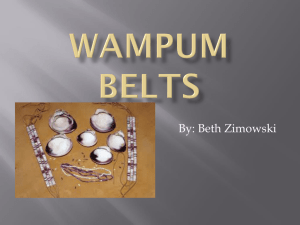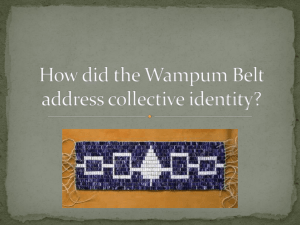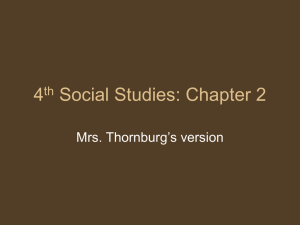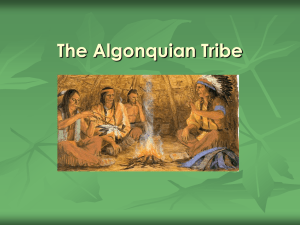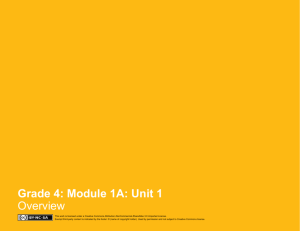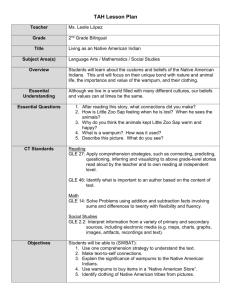Wampum project 1 - Crossroads of Empire
advertisement
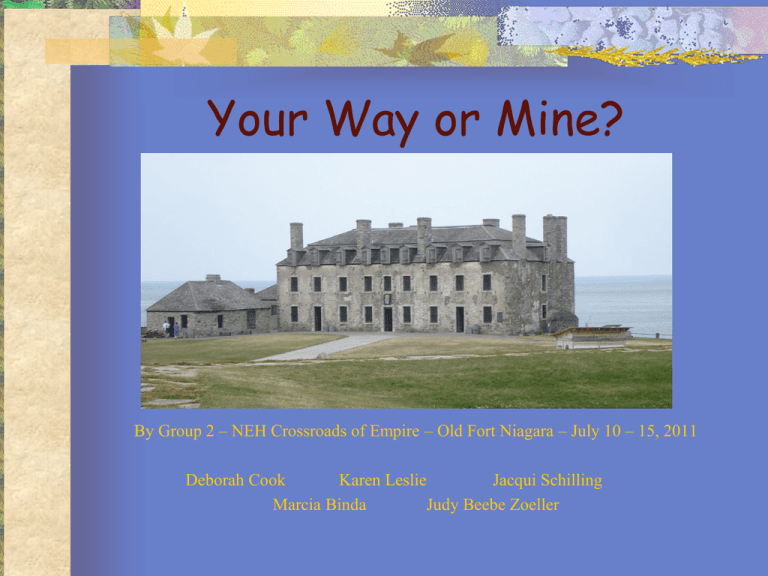
Your Way or Mine? By Group 2 – NEH Crossroads of Empire – Old Fort Niagara – July 10 – 15, 2011 Deborah Cook Karen Leslie Jacqui Schilling Marcia Binda Judy Beebe Zoeller What Is Wampum? • Wampum are long cylinder beads in white and purple made from shells of clams. • Early Atlantic Indians used wampum for trade and decoration. • Iroquois used wampum to bring peace, bind peace, and take the place of blood. • Wampum strings served as credentials or agreements and became something sacred. From: Wampum Belts of the Iroquios by Tehanetorens Making Wampum http://www.nativetech.org/wampum/wamphist.htm The Huron Wampum Belt commemorates the 1683 agreement between the Hurons and Jesuit missionaries for the construction of the first wooden church on Huron Lands. Adapted from The Native Americans. Edited by B. & I. Ballantine. 1993. The Great Chain, or Covenant Belt, is generally thought to be a belt presented by the U.S. government to the Iroquois in 1794 at the Pickering Treaty at Canandaigua, N.Y. The human figures, each linked by a wampum belt, form a chain of friendship, representing the alliance between the thirteen states and the Iroquoian confederacy. Adapted from The Native Americans. Edited by B. & I. Ballantine. 1993. The Fort Stanwix Treaty Belt was exchanged at the signing of the Treaty between the Six Nations and the United States at Fort Stanwix (Rome, NY) October 22, 1784. At this treaty the Six Nations was guaranteed the right of occupancy forever in the immemorial domain of the Iroquois League. The United States further promised to prevent anyone, including any state, from taking their lands or from interfering in the internal affairs of the Six Nations. Fort Stanwix Treaty Friendship Belt This belt commemorates the Peace Treaty of November 1756. After the completion of the Woods’ Edge Ceremony, the Iroquois and Governor William Denny both offered condolences. Both sides accepted the others’ kindness. After this, a day of non-official meeting took place to discuss plans of a treaty. Official negotiations took place the next day and the treaty was signed. Other Examples of Wampum Make Your Own Virtual Wampum Belt • Go to the following link and make your own wampum belt. Make sure you can explain the significance of your belt design. • http://www.nativetech.org/beadwork/wamp umgraph/index.html Make Your Own Wampum Belt Using available materials create your won wampum belt. Make sure you can explain the significance of your belt design. Suggested materials may include but not limited to: Beads macaroni straws String fishing line mosaic tiles/paper “Thanksgiving Address” and Reader’s Theater Art Reenactment • Use artwork to bring history alive by becoming a part of the painting and using keen observation skills. • Ask several students to replicate the positions of key people in a piece of artwork. • By asking leading questions lead students to more deeply observe and understand. First Contact • • • • “Chute d’eau de Niagara” Samuel Champlain wrote about these falls in 1603. Assign one student to represent the one of the Europeans at the top of the falls, and one to be the native people at the bottom of the falls. Questions you could ask of each volunteer student or of the class. • What are you seeing in this picture? • What are you feeling in this picture? • Where are the Europeans? Where are the natives? Why to you think they are in these places. Adoption of Mary Jemison “Mary Jemison was 15 at the time of her abduction. She was taken from her home in Gettysburg, PA. She was marched to Fort Duquesne with other members of the family where she was adopted by two Seneca sisters. Years later when released from her so called captives, she chose to remain with the Seneca people, and married and raised a family. She was a highly respected member of the tribe. Mary died at 1833 at the age of 91.” • From Robert Griffing art website The Adoption of Mary Jemison • Choose five students to replicate positions in the painting. (Mary, a sister, an on looking woman, a elder man, and the little boy. • What is each person thinking? • Why do you think the elder man is in the back? • What do you think is happening today, and what might be happening in the future? • What other things do you notice? • What do you think is the story? Portage • • “Native Americans traveling the waterways of North America were constantly confronted with nonnavigable sections of river where canoes and baggage had to be transported over land, around falls and rapids. Sometimes the portage was as treacherous as the river itself. Carrying their heavy burdens, Indians and Europeans often fell to their deaths trying to negotiate rocky terrain and steep cliffs.” Robert Griffing The Great Treaty • “The Canadaigua Treaty is between the Haudenosaunee ( Six Nations Iroquois Confederacy) and the United States of America – one of the first treaties the United States entered into. This treaty, drafted in Canadaigua, New York, which created a lasting peace of friendship between the Six Nations and the United States, was signed November 11, 1794. • Robert Griffing Bibliography • “NativeTech: American Technology and Art.” 14 July. 2011. http://www.nativetech.org/wampum/wamphist.htm • “Impressions of Niagara.” Castellani Art Museum. 14 July.2011. http://purple.niagara.edu/cam/Niagara/impr18c.html • Thanksgiving Address. http://www.nativevillage.org/Inspiration-/iroquois_thanksgiving_address.htm • Fort Stanwix Treaty. http://www.cayuganation-nsn.gov/LandRights/Treaties/TreatyofFortStanwix • Taylor, Alan. The Divided Ground. New York: Random House, 2006 • Peacemakers for the 21st century. (www.teachablemoment.org/elementary/peacemakers.html). • Lord Nelson’s Gallery. Robert Griffing (artist). http://www.lordnelsons.com/gallery/frontier/griffing/84.htm
